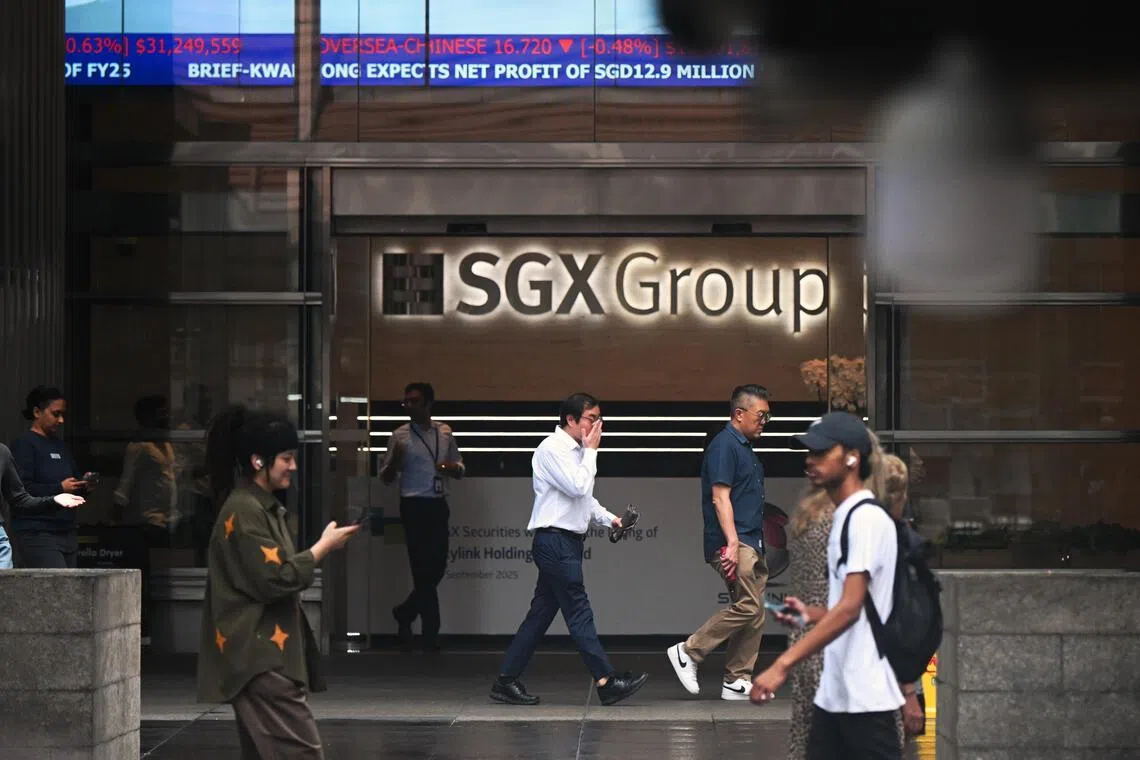Market Insights
Singapore’s economy could reach $1.5 trillion by 2040, lift STI to 10,000, predicts DBS
Sign up now: Get ST's newsletters delivered to your inbox

A culture of risk-taking is critical to catalyse Singapore's structural strengths to long-term growth, according to DBS.
ST PHOTO: KUA CHEE SIONG
Follow topic:
- DBS projects the STI could reach 10,000 by 2040, underpinned by Singapore's economic growth to US$1.2-1.4 trillion.
- MAS will launch the “Value Unlock” programme and consult on investor recourse, aiming to boost listed companies and attract high-growth tech listings.
- Wee Hur's property arm won a condo site bid for $613.9 million, while ST Engineering secured $4.9 billion in new contracts across various sectors.
AI generated
SINGAPORE - The Straits Times Index (STI) rose over the week to close at just above 4,422 on Oct 24, after the launch of a DBS Bank report projecting that the blue-chip benchmark could reach 10,000 points by 2040
The DBS Singapore 2040 report, released on Oct 22, also noted that the Singdollar could reach parity with the US dollar over the 15-year period, supported by the potential expansion of the local economy to between US$1.2 trillion (S$1.56 trillion) and US$1.4 trillion by 2040 from US$547 billion in 2024.
Singapore has seen a stock market rally that has driven the STI to record highs in 2025 despite global geopolitical and tariff uncertainties.
The real estate sector showed the biggest positive change year to date from 2024, while financial services, industrials, communications services, and information technology sectors all recorded growth, DBS said.
Attractive yields and valuations, as well as low domestic interest rates, have also helped increase the Republic’s appeal to investors.
“The ability to offer attractive dividend yields appears to have become part of the Singapore equity market’s DNA,” said the report.
A target of 10,000 points by 2040 would mean that the index would need to see a further gain of 126.1 per cent in the next 15 years.
While the goal is ambitious, Singapore could reach it if the market addresses its underinvestment issues and improves liquidity and trading activity, the report said.
For example, safe-haven inflows from US and Europe passive funds could offset outflows from active funds, driving growth in large-cap stocks.
Stocks in the income and staples categories should also benefit from the fall in domestic interest rates, as depositors redeploy their funds from the money market, fixed deposits and high-yield current and savings accounts.
For smaller stocks, the Monetary Authority of Singapore’s (MAS) Equity Market Development Programme (EQDP) will be key to sustaining interest.
DBS forecasts a potential $137.4 billion liquidity injection into the Singapore equity market – well above the EQDP’s $5 billion allocated – should the market’s size relative to money supply improve.
More risk-taking needed
DBS noted that Singapore’s market will need a stronger culture of calculated risk-taking, and called for “a deliberate, marketwide shift towards responsible risk-taking” to unlock the country’s long-term growth potential.
Singapore is facing a critical juncture in attracting high-growth tech companies to list locally rather than on overseas exchanges, the report said, citing Grab and Sea’s US listings as examples.
It added that with rising opportunities in artificial intelligence and advanced manufacturing, the Singapore Exchange could become the region’s preferred exchange for tech companies, if aided by rules that speed up new listings and their entry into the STI, which has so far limited exposure to high-growth sectors.
Investors in Singapore may also need to get more comfortable with backing faster-growing, higher-valued companies
The Government will offer help to enable listed companies to deliver greater shareholder value and actively engage investors on their business plans.
It will announce more details of its “Value Unlock” programme in November, which will include government grants, toolkits and an expanded suite of engagement platforms, said MAS deputy chairman and Minister for National Development Chee Hong Tat at the launch of the DBS report on Oct 22.
MAS will also consult on proposals to enhance investor recourse
The regulator is also on track to announce the second batch of fund managers that will be appointed under the EQDP.
They will comprise global, regional and local managers with good capabilities in Singapore equities, such as proven track records in attracting institutional flows and broadening market liquidity.
The first batch of managers were announced in July, with Fullerton Fund Management and Avanda Investment Management already releasing details of their Singapore Value-Up and Singapore Discovery funds, respectively.
J.P. Morgan Asset Management has yet to reveal its cards.
The MAS equities review group is expected to complete its review by the end of 2025.
Construction firms get in on the action
Shares of construction company Wee Hur jumped last week. The counter is up 6.4 per cent through the week, and closed Oct 24 at 75 cents.
The group announced on Oct 23 that its property arm and controlling shareholder GSC Holdings had outbid four other contenders with a $613.9 million offer for a condominium site in Upper Thomson.
Wee Hur’s bid works out to a land price of $1,061.56 per sq ft per plot ratio (psf ppr), slightly above analysts’ forecasts of $900 to $1,050 psf ppr in a poll by The Business Times.
Wee Hur and GSC Holdings expect the average selling price of the upcoming development to be around $2,300 psf or more, with a potential launch date in 2027.
Wee Hur’s bid beat the second-highest offer from Frasers Property, Soilbuild Group, and CYZ Land by 2 per cent.
The rival bid was $601.5 million, equivalent to $1,040.06 psf ppr.
Wee Hur also announced on Oct 22 that its wholly owned subsidiary Wee Hur Property has entered into a joint venture to develop Wycombe Abbey School (Singapore) in Hougang Avenue 3.
Meanwhile, Soilbuild is considering the possibility of spinning off its precast and prefabrication business and listing it on the SGX mainboard, according to a bourse filing on Oct 21.
The builder noted that its plans are still in an exploratory stage, with details such as the structure, timing and terms of the potential listing yet to be determined.
Shares of the company briefly spiked 1.92 per cent when the counter opened on Oct 22.
It closed the week at $3.47, down 0.86 per cent from a week ago.
Hong Leong Asia shares tumble
Hong Leong Asia shares tumbled on Oct 22, following news that two staff employed by its subsidiaries in China had been detained by the authorities.
The reasons why China Yuchai International (CYI) director and Guangxi Yuchai Machinery president Wu Qiwei and Guangxi Yuchai Machinery’s former chief accountant Qin Xiaohong were detained have not been disclosed.
CYI is Hong Leong Asia’s subsidiary headquartered in Singapore and listed on the New York Stock Exchange.
It operates primarily through Guangxi Yuchai, which specialises in the design, manufacture, assembly and sale of engines for heavy vehicles, construction and agricultural equipment, as well as marine and power generation applications.
It reported a 52.2 per cent increase in net profit for the first half of 2025, up from 240.3 million yuan (S$43.8 million) to 365.8 million yuan, on the back of higher sales of engines.
CYI’s shares fell 14.3 per cent from its US$35 per share close on Oct 17 to US$29.97 when the market opened on Oct 20, but rebounded to close Oct 24 at US$37.05, up more than 24 per cent through the week.
Shares of Hong Leong Asia fell by 20.6 per cent on Oct 21 to $2, but pared some losses through the week to close Oct 24 at $2.44.
Gold’s hot streak ends, hits CNMC Goldmine
The recent surge in gold prices came to an abrupt halt last week as investors locked in profits.
After hitting an all-time high of US$4,381.21 an ounce on Oct 20, spot gold fell as much as 6.3 per cent to $4,082.03 the next day, snapping a nine-week rally.
Silver and platinum also slumped sharply on Oct 21, down 7 per cent and 5 per cent, respectively.
Gold closed the week at US$4,113.48 an ounce.

Gold closed the week at US$4,113.48 an ounce.
PHOTO: REUTERS
Singapore-listed gold mining company CNMC Goldmine plunged after rising more than 400 per cent so far in 2025.
The counter fell as much as 12.4 per cent to $1.06 on Oct 22 before paring losses to close on Oct 24 at $1.17.
Analysts said that gold’s pullback is part of a consolidation phase, with the market taking in profits from the surge, and miners such as CNMC tend to be harder hit by such corrections owing to their earnings being more leveraged to metal prices and costs.
Miners could face further declines before stabilising if sentiment continues to weaken, they added.
While a further cooling off of gold’s price is expected, most experts remain optimistic about gold owing to falling US real interest rates, heightened geopolitical risks and sustained central bank buying.
On Oct 23, J.P. Morgan said it expects gold prices to reach US$5,055 an ounce by the fourth quarter of 2026.
It said that its forecast is based on assumptions that investors and central banks will buy around 566 tonnes of gold a quarter on average in 2026.
Other market movers
ST Engineering closed Oct 24 at $8.58, up more than 4 per cent through the week, after it announced on Oct 23 that it had secured $4.9 billion in new contracts in the third quarter of 2025.
This comprises $1.4 billion from the commercial aerospace segment, $2.4 billion from the defence and public security arm, and $1.1 billion from the urban solutions and satellite communications (satcom) segment.
It also amounts to around one-third of the total contracts won by the company in the first nine months of 2025, worth $14 billion.
Major aerospace contracts won in the third quarter include a multi-year agreement for Airbus A380 airframe heavy maintenance and cabin modification with a European airline, and an A330 passenger-to-freighter order for its freighter conversion business.
For its defence and security segment, the company was awarded contracts to design and produce earth observation satellite systems for an international customer, as well as provide artificial intelligence-powered 5G solutions for local and international enterprise customers.
Other contracts secured for the digital systems and cyber business included those related to next-generation broadband communications systems, as well as commercial satellite imagery and analytics services.
The land systems business secured ammunition orders from customers in South America and Eastern Europe, as well as repeat orders for ammunition from international clients; while the marine segment won a contract with Siemens Energy to build and deliver a barge-mounted power plant in the Dominican Republic.
On the domestic front, ST Engineering’s urban solutions business landed contracts to provide rail electronics solutions for the Thomson-East Coast Line extension and long-term service support for its rail sub-systems on the Jurong Region Line.
Its smart utilities and infrastructure business was contracted to deliver its integrated smart security management solution to customers in Singapore, including a tertiary institution. It will also deploy its Doctor-on-Call healthcare tech solution for hospitals in Hong Kong.
The satcom business received ground segment infrastructure contracts from satellite service providers in Asia, Europe, the Middle East and the US, among other entities.
What to look out for this week
Markets could be volatile with the US Federal Reserve scheduled to announce its monetary policy and interest rate decision on Oct 30.
The Fed is widely expected to cut rates by a quarter of a percentage point from the current range of 4 per cent to 4.25 per cent.


